Figure 7.
TFP increases endogenous ROS production after DNA-damaging treatment. U1810 cells were exposed to DNA-damaging drugs (2.5 μg/ml bleomycin, 20 μM cisplatin) alone or in combination with TFP (10 μM). Intracellular ROS was measured by oxidation of the probe CM-H2DCFDA. Short-term cell viability was assayed by PI exclusion after 48 h (bleomycin) or 72 h (cisplatin); long-term clonogenic capacity was determined by standard colony formation assay after 9 days. (a) TFP-co-treated cells showed time-dependent increases in ROS production after exposure to bleomycin (left). The histogram (right) highlights differences in DCFDA-associated fluorescence after 24 h: shaded, bleo; unshaded, bleo+TFP. (b) TFP-co-treated cells showed time-dependent increases in ROS production after exposure to cisplatin. (c) N-acetylcysteine (NAC) partially rescued the short-term viability of cells co-treated with TFP and bleomycin (top) or cisplatin (bottom). NAC (10 mM, 48 h) was added immediately after bleomycin treatment and replenished once after 24 h. (d) NAC antagonized the suppression of long-term clonogenic capacity by TFP co-treatment. Filled columns, experimental data; open column, additive combinatorial effect as predicted by the Bliss model. Mean and S.D. were compiled from three to five independent experiments performed in duplicates (*P<0.05, TFP co-treatment versus single-agent bleo/cis treatment, §P<0.05, predicted additive combinatorial effects of TFP co-treatment plus NAC versus observed combinatorial effects of TFP co-treatment plus NAC)

